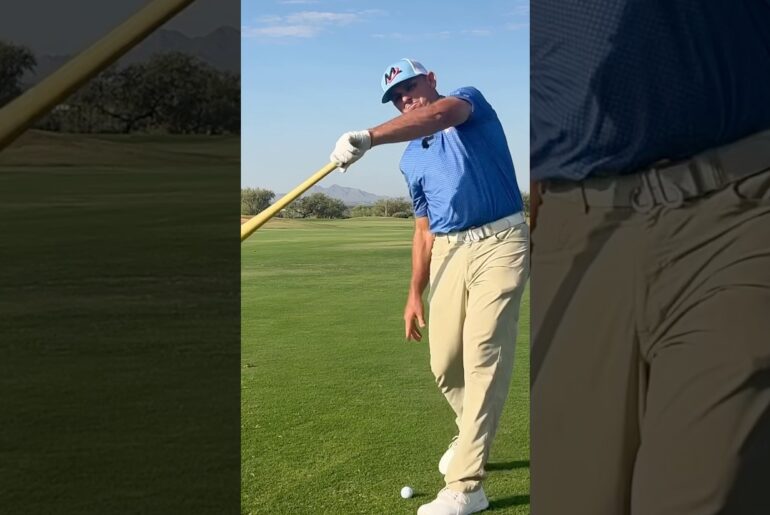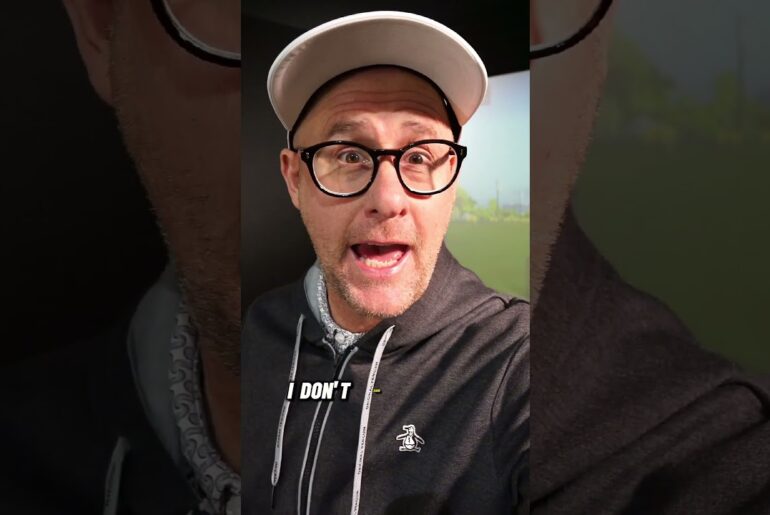If you’ve been struggling your whole life to hit a draw, or if you’re just beginning to play, use this step-by-step progression in the video to learn how to hit a crisp, powerful draw.
I use a one-piece takeaway – which means that I begin the back swing by only rotating my shoulders, arms stay locked in place. Maintain your spine angle and rotate around that axis. For a full swing, rotate until your left shoulder (for right-handers) is under your chin and pointing at the ball. Grip the club lightly with a slightly closed face at address. Place the ball at about center of your stance.
Drill 1: For the first drill, use a short shoulder turn/backswing, as if you were chipping, and do not manipulate your wrists. Let gravity be your friend – just let the club drop at the start of the downswing. Both elbows should stay tucked to your side, near your hips. Your hands need to be ahead of the ball at impact.
The ball should have a low launch angle, and a slight right to left curve. With a small swing it should travel 20 – 50 yards with a 7 or 8 iron. Do not move to the next drill until you’ve mastered this one, and so on.
Drills 2 & 3: In these drills, I add wrist flexion and “cocking” of the wrists, but a better sequence may be to go to a half swing without manipulating your wrists just yet. Wrist flexion is when your move you palm down toward your forearm; extension is when you move the back of your hand towards your forearm. In the video I keep saying “wrist flexion” when I should have said “wrist extension,” and I am referring to my right hand. Cocking the wrist is known as radial deviation, like doing a thumbs up. Radial deviation and wrist extension gives you “lag” and is a source of power. It’s called lag because it causes the club head to lag behind your hands. You do this naturally when you swing a hammer or baseball bat. Never extend your left wrist (known as “cupping”) until after impact. Always keep your left wrist neutral, or slightly flexed. DJ keeps his significantly flexed from the top of his swing through impact, giving him a powerful draw.
In Drill 2, I am only adding wrist extension; then adding radial deviation (cocking the wrists) in Drill 3.
Drill 4: Increase your backswing to where you’re left arm is at least parallel to the ground and your shaft is pointing nearly vertical. As mentioned above, if cocking and extending your right wrist is causing mishits, then just keep your wrists fixed. Remember, however that your grip and forearm muscles need to stay relaxed, or else you will start forcing the clubhead to come around prematurely – this is known as “flipping the club” and will usually result in pulling the ball left or topping it. Your ball flight should now be higher, and should be carrying 70 – 100 yds with a baby draw.
Drill 5: This is where you do a full backswing and put everything together. The key is to not change your tempo. If you try to swing too hard or too fast to get more distance, several things can go wrong. One thing that can happen is that your hands get way out ahead of the clubhead and you push the ball to the right, with an open face, also resulting in a slice, and lost ball. The other most common thing is that you will start turning your right shoulder at the start of the downswing, causing your club to break the plane and come from the outside-in to reach the ball – this is known as “coming over the top”. When you do this your ball will start left, and will generally slice back to the right because your body tries to compensate for the pull by opening the clubface. Once you’ve mastered these four drills, you will be hitting a nice high draw that carries between 140 – 160 yards, and has a nice crisp sound at impact.
When you’re inside 100 yards, just open your stance and your clubface a little, and move the ball slightly forward of center to get a nice high fade that will have backspin and stick the green.
Hope this helps, and play well!
T.C.






